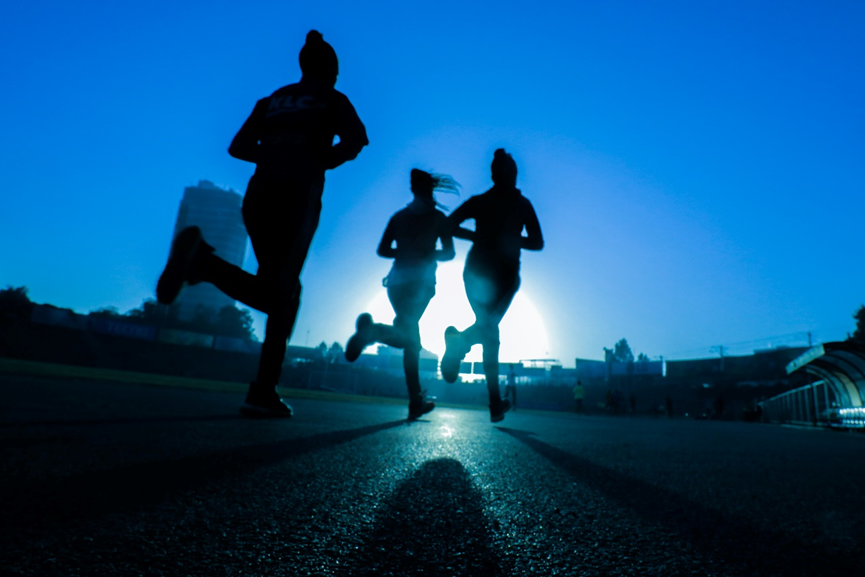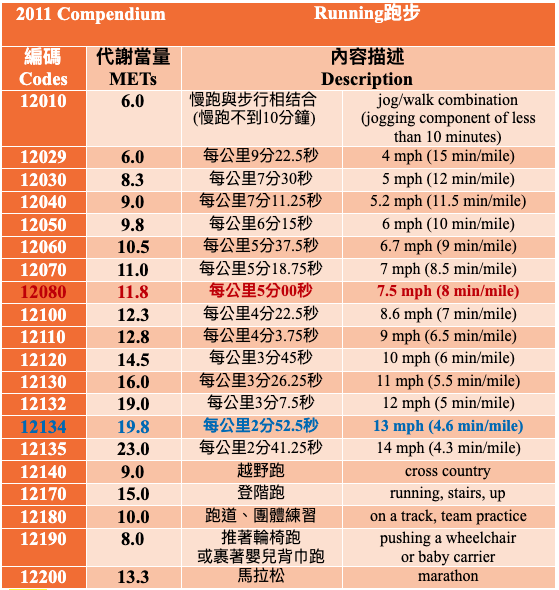【跑步二三事】透過代謝當量 計算出跑步時消耗的熱量!

(圖片來源: Jonathan Chng on Unsplash)
延續上一週專欄文章《透過說話測試,判斷你的運動強度!》,若要談論運動強度與訓練總量,我們可以亦透過代謝當量(METs, Metabolic Equivalent of Tasks)來計算,它是指特定活動的狀態之下相對於安靜休息狀態(通常是安靜坐著)的能量消耗,而 1 MET 相當於 1 個人在安靜休息時,每公斤體重在每 1 小時消耗 1 大卡(kcal/kg/hour)的熱量或是每公斤體重每分鐘消耗 3.5 毫升的氧氣(ml/kg/min)。
舉例來說,若 1 MET 代表安靜休息時的能量消耗,那麼 8 METs 則表示能量消耗是休息時的 8 倍; 一位 70 公斤的男性,在安靜休息時,每小時會消耗 70 大卡,或者是說每小時消耗 70*3.5*60=14,700 毫升的氧氣(14.7 公升)。

(圖片來源: Fitsum Admasu on Unsplash)
美國亞利桑那州立大學的營養與健康促進學院在 2011 年更新了各項身體活動的代謝當量(如表 1),本文擷取有關跑步的代謝當量,並將英制轉換為公制,方便閱讀與計算。
*註 1:跑步的代謝當量是綜合整理過去 17 篇文獻而得,詳細資訊如文末參考文獻。
*註 2:本表是從 1993 年推出後開始修訂,最新且最完整的一次版本為 2011 年版。
表 1 有關跑步的代謝當量表

舉例 1:一位體重 70 公斤的市民跑者以每公里 5 分整(編碼 12080)的速度慢跑 1.5 小時,那麼請問他將消耗多少熱量?
活動消耗能量=代謝當量(METs)* 體重(kg)* 時間(hour)
該強度下的代謝當量:11.8 METs;1 MET= 1 kcal/kg/hr
估算該活動所消耗的總熱量:11.8 METs× 70 kg × 1.5 hrs = 1,239 kcal
舉例 2:若以每公里 2 分 52.5 秒的平均速度(編碼 12134)完成全程馬拉松,時間會是 2 小時 01 分18.6 秒,比目前正規的全馬男子世界紀錄 2 小時 01 分 39 秒來得快。假設體重 52 公斤的 Eliud Kipchoge 用這個配速完成全馬並締造新的世界紀錄,那麼他將消耗多少熱量?
活動消耗能量=代謝當量(METs)* 體重(kg)* 時間(hour)
該強度下的代謝當量:19.8 METs;1 MET= 1 kcal/kg/hr
估算該活動所消耗的總熱量:19.8 METs× 52 kg × (2+0.022) hrs = 2,082 kcal
*註 3:1 分 18.6 秒約為 0.022 小時
*註 4:Eliud Kipchoge 曾經二度挑戰全馬跑進二小時內,分別是 Breaking 2 Project 與 INEOS 1:59 Challenge,但因挑戰中途輪流上陣的配速員們、場地丈量起訖站距離等因素不符合世界田徑(World Athletics)的規定而不列入正規的世界紀錄。

(圖片來源: Miguel A. Amutio on Unsplash)
代謝當量是一種評估強度的方式,將單位強度乘以運動時間便能估算消耗的熱量,仍需考量到性別、年齡、身體代謝率、遺傳、是否罹患代謝相關疾病等因素。除此之外,代謝當量是指概算的情況,例如編碼 12200 的馬拉松項目為 13.3METs,但不代表所有跑馬拉松的人,都能完全類推適用,但它仍具有在短時間內分辨強度的好處。
參考文獻:
- Abel, M., J. Hannon, et al. (2008). Validation of the Kenz Lifecorder EX and the ActiGraph GT1M accelerometers for walking and running in adults. Applied Physiology of Nutrition and Metabolism 33: 1155-1164.
- Costill, D. and E. Fox (1969). Energetics of marathon running. Medicine and Science in Sports 1(2): 81-86.
- Costill, D., H. Thomason, et al. (1973). Fractional utilization of the aerobic capacity during distance running. Medicine and Science in Sports 5: 248-252.
- Crouter, S. E., K. G. Clowers, et al. (2006). A novel method for using accelerometer data to predict energy expenditure. Journal of Applied Physiology 100: 1324-1331.
- Cureton, K., R. Boileau, et al. (1975). Structural and physiological evaluation of Craig Virgin, 1975 NCAA cross country champion. Physical Fitness Laboratory. Champaign, University of Illinois.
- Haymes, E. M. and W. C. Byrnes (1993). Walking and running energy expenditure estimated by Caltrac and indirect calorimetry. Medicine and Science in Sports and Exercise 25(12): 1365-1369.
- Mayhew, J. (1977). Oxygen cost and energy expenditure in trained runners. British Journal of Sports Medicine 11(3): 116-121.
- Mayhew, J. and J. Andres (1975). Assessment of running performance in college males from aerobic capacity percentage utilization coefficients. Journal of Sports Medicine and Physical Fitness 15: 342-346.
- McArdle, W. D., F. I. Katch, et al. (1981). Exercise Physiology: Energy, Nutrition, and Human Performance. Philadelphia, Lea & Febiger.
- Mercer, J., J. Dolgan, et al. (2008). The physiological importance of preferred stride frequency during running at different speeds. Journal of Exercise Physiology 11(3): 26-32.
- Pugh, L. (1970). Oxygen intake in track and treadmill running with observations on the effect of air resistance. Journal of Physiology 207: 823-835.
- Sentija, D. and G. Markovic (2009). The relationship between gait transition speed and the aerobic thresholds for walking and running. International Journal of Sports Medicine 30(11): 795-801.
- Sherrman, W., D. Morris, et al. (1998). Evaluation of a commercial accelerometer (Tritrac-R3D) to measure energy expenditure during ambulation. International Journal of Sports Medicine 19: 43-47.
- Taylor, H., D. R. J. Jacobs, et al. (1978). A questionnaire for the assessment of leisure time physical activities. Journal of Chronic Disease 31: 741-755.
- Welk, G. J., S. N. Blair, et al. (2000). "A comparative evaluation of three accelerometry-based physical activity monitors." Medicine
and Science in Sports and Exercise 32(9): S489-S497.
- Wulff, S., J. Cochrane, et al. (1998). Energy cost and energy expenditure of running in trained females. International Association for Health Physical Education Recreation and Dance 31(2). from http://www.iowaahperd.org/journal/j98s_energy.html.
- Wyndham, C. S., NB, C. van Graan, et al. (1971). The energy cost of walking and running at different speeds. South African Medical Journal 45: 50-53.
責任編輯:哈卡
圖片來源:Unsplash
*跑步好知識,盡在運動筆記*
往下滑看下一篇


確定要檢舉這則留言嗎?
取消 檢舉檢舉完成